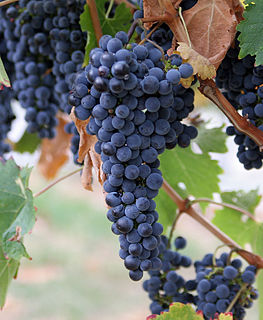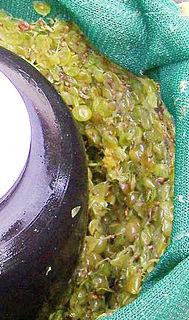Related Research Articles

A grape is a fruit, botanically a berry, of the deciduous woody vines of the flowering plant genus Vitis.

Brandy is a liquor produced by distilling wine. Brandy generally contains 35–60% alcohol by volume and is typically consumed as an after-dinner digestif. Some brandies are aged in wooden casks. Others are coloured with caramel colouring to imitate the effect of aging, and some are produced using a combination of both aging and colouring. Varieties of wine brandy can be found across the winemaking world. Among the most renowned are Cognac and Armagnac from southwestern France.
Pisco is a colorless or yellowish-to-amber colored brandy produced in winemaking regions of Peru and Chile. Made by distilling fermented grape juice into a high-proof spirit, it was developed by 16th-century Spanish settlers as an alternative to orujo, a pomace brandy that was being imported from Spain. It had the advantages of being produced from abundant domestically grown fruit and reducing the volume of alcoholic beverages transported to remote locations.

Tsipouro is a Geographical Indication for pomace raki in Mainland Greece and in particular Thessaly, Epirus, Macedonia. Tsipouro is a strong distilled spirit containing 40–45% alcohol by volume and is produced from either the pomace or from the wine after the grapes and juice have been separated. It comes in two types, pure and anise-flavoured, and is usually not aged in barrels, although barrel aged versions do exist.

Winemaking or vinification is the production of wine, starting with the selection of the fruit, its fermentation into alcohol, and the bottling of the finished liquid. The history of wine-making stretches over millennia. The science of wine and winemaking is known as oenology. A winemaker may also be called a vintner. The growing of grapes is viticulture and there are many varieties of grapes.
Rakia, rakija or Raki, is the collective term for fruit spirits popular in the Balkans. The alcohol content of rakia is normally 40% ABV, but home-produced rakia can be stronger.

Pomace, or marc, is the solid remains of grapes, olives, or other fruit after pressing for juice or oil. It contains the skins, pulp, seeds, and stems of the fruit.

Grappa is an alcoholic beverage: a fragrant, grape-based pomace brandy of Italian origin that contains 35 to 60 percent alcohol by volume. Grappa is traditionally produced in Northern Italy and is also widely consumed in places such as Argentina, Bulgaria, Georgia, Uruguay and Galicia.

Aguardiente, in Spanish, or Aguardente, in Portuguese is a generic term for alcoholic beverages that contain between 29% and 60% ABV. It originates in the Iberian Peninsula, as well as Iberian America.

Zivania or zivana is a Cypriot pomace brandy produced from the distillation of a mixture of grape pomace and local dry wines made from Xynisteri and Mavro grapes. The name of zivania is derived from zivana which means pomace in the Greek dialect of Cyprus. Zivania is colourless and alcoholic with a light aroma of raisins. Its alcohol content varies, with 45% by volume being the typical value. As defined by law, zivania shall not have more than 60% alcohol content. Zivania contains no sugars and has no acidity.

The following outline is provided as an overview of and topical guide to wine

Straw wine, or raisin wine, is a wine made from grapes that have been dried to concentrate their juice. The result is similar to that of the ice wine process, but is a much older process and suitable for warm climates. The technique dates back to pre-Classical times with wines becoming fashionable in Roman times and in late Medieval/Renaissance Europe when wines such as Malmsey and Candia were highly sought after. Traditionally, most production of these wines has been in Greece, the islands off Sicily, Cyprus, Northern Italy and the French Alps. However producers in other areas are now using with the method too.

The modern Indian Wine market is small but growing; annual per capita consumption of wine in the country is a mere 9 milliliters, approximately 1/8000th that of France. The main reason for this can be attributed to the fact that Indians preference for hard liquor and beer boasts nearly 98% of market share whereas wine with low ABV only has 2% market share. The Viticulture in India has a long history dating back to the time of the Indus Valley civilization when grapevines were believed to have been introduced from Persia. Winemaking has existed throughout most of India's history but was particularly encouraged during the time of the Portuguese and British colonization of the subcontinent. The end of the 19th century saw the phylloxera louse take its toll on the Indian wine industry followed by religious and public opinion moving towards the prohibition. Following the country's independence from the British Empire, the government encouraged vineyards to convert to table grape and raisin production. In the 1980s and 1990s, a revival in the Indian wine industry took place as international influences and the growing middle class started increasing demand for the beverage. By the turn of the 21st century, demand was increasing at a rate of 20-30% a year. The city of Nashik in the state of Maharashtra is called the "Wine Capital of India."
European Union wine growing zones are used in the common European Union wine regulations to regulate certain aspects of winemaking. The zones differ in terms of climate and examples of what is regulated by wine growing zone are required grape maturity at harvest and allowed levels of chaptalisation. There are 21 wine producing countries in the European Union, with 14 of them having significant levels of production. In the 2004-2005 vintage, total European Union wine production was around 184 million hectoliters which accounted for nearly 70% of total worldwide production. Of that total, nearly 55% was classified as table wine with 4% used in the production of grape-based distilled spirits such as Armagnac and Cognac.
European Union wine regulations are common legislation related to wine existing within the European Union (EU), the member states of which account for almost two-thirds of the world's wine production. These regulations form a part of the Common Agricultural Policy (CAP) of EU, and regulate such things as the maximum vineyard surface allowed to individual EU member states, allowed winemaking practices and principles for wine classification and labelling. The wine regulations exist to regulate total production in order to combat overproduction of wine and to provide an underpinning to Protected designations of origin (PDOs), among other things. In a sense, the wine regulations therefore try to protect both the producer and the consumer.

The Parc de Belleville, one of the parks and gardens of the 20th arrondissement of Paris, is situated between the Parc des Buttes Chaumont and the Père Lachaise Cemetery.

Pressing in winemaking is the process where the juice is extracted from the grapes with the aid of a wine press, by hand, or even by the weight of the grape berries and clusters. Historically, intact grape clusters were trodden by feet but in most wineries today the grapes are sent through a crusher/destemmer, which removes the individual grape berries from the stems and breaks the skins, releasing some juice, prior to being pressed. There are exceptions, such as the case of sparkling wine production in regions such as Champagne where grapes are traditionally whole-cluster pressed with stems included to produce a lighter must that is low in phenolics.
Törkölypálinka is a Hungarian pomace brandy, an alcoholic beverage produced by distillation from grape residues (pomace) left over from winemaking. One of the oldest types of pálinka, it is thought to aid digestion, and is usually consumed in small quantities after meals.

The history of the wine press and of pressing is nearly as old as the history of wine itself with the remains of wine presses providing some of the longest-serving evidence of organised viticulture and winemaking in the ancient world. The earliest wine press was probably the human foot or hand, crushing and squeezing grapes into a bag or container where the contents would ferment.

Raki or rakı is a sweetened, often anise-flavoured, alcoholic drink that is made in Greece and popular in Albania, Turkey and other Balkan countries as an apéritif. It is often served with seafood or meze. It is comparable to several other alcoholic beverages available around the Mediterranean and the Middle East, e.g. pastis, ouzo, sambuca, arak and aguardiente.
References
- 1 2 3 Jancis Robinson, ed. (2006). "Piquette". Oxford Companion to Wine (Third ed.). Oxford: Oxford University Press. pp. 532. ISBN 0-19-860990-6.
- ↑ Cliffordawright.com: Wine as Food in 15th century Languedoc, accessed 27 May 2008
- ↑ Council Regulation (EC) No 1493/1999 of 17 May 1999 on the common organisation of the market in wine, p. 42
- ↑ Council Regulation (EC) No 1493/1999, p. 24
- ↑ "The Encyclopedia of Food and Beverage by Artemas Ward, New York, 1911". Digital.lib.msu.edu. Archived from the original on 12 February 2010. Retrieved 26 April 2011.
- 1 2 The Paris Times 25 May 2007: Rebellious Belleville
- ↑ Clotilde (10 August 2005). "10 August 2005: Drink Local, Drink Montmartre!". Chocolateandzucchini.com. Retrieved 26 April 2011.